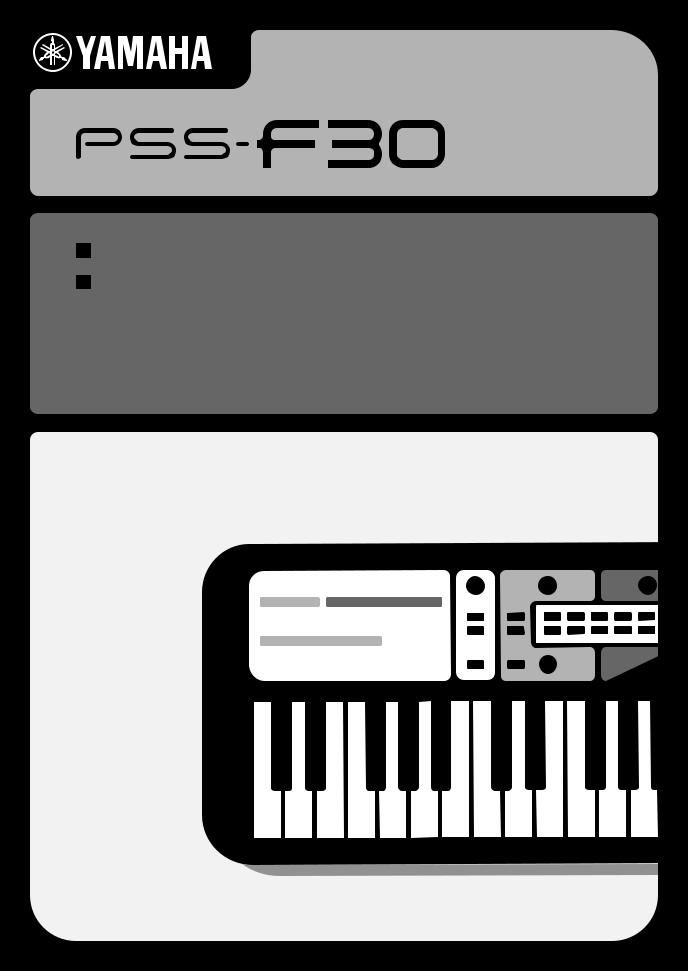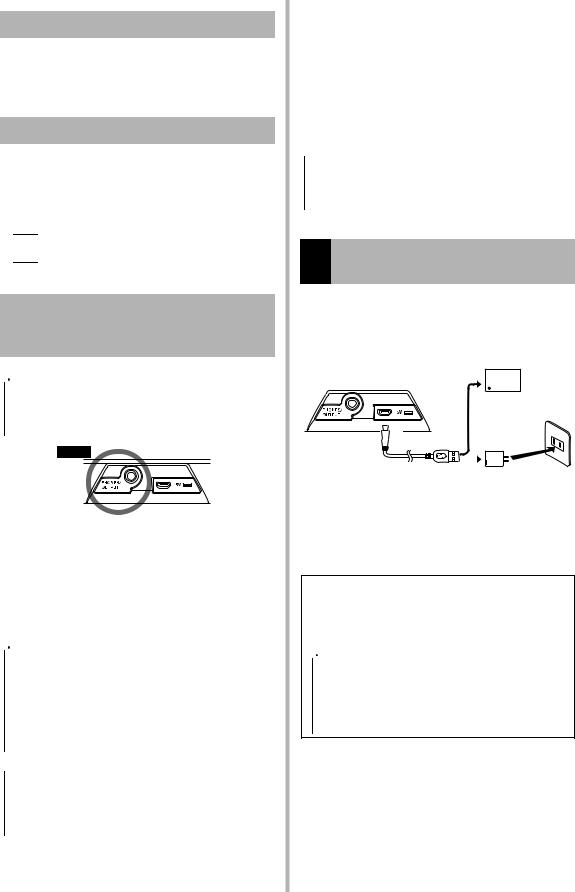Yamaha PSS-F30 User Manual

D I G I TA L K E Y B OA R D
O w n e r ’s M a n u a l
Thank you for purchasing this Yamaha Digital Keyboard!
This instrument is a portable keyboard featuring a wide variety of sounds and functions.
We recommend that you read this manual carefully so that you can fully take advantage of the advanced and convenient functions of the instrument. We also recommend that you keep this manual in a safe and handy place for future reference.
Before using the instrument, be sure to read “PRECAUTIONS” on pages 4-5.
E N

SPECIAL MESSAGE SECTION
This product utilizes batteries or an external power supply (adapter). DO NOT connect this product to any power supply or adapter other than one described in the manual, on the name plate, or specifically recommended by Yamaha.
WARNING: Do not place this product in a position where anyone could walk on, trip over, or roll anything over power or connecting cords of any kind. The use of an extension cord is not recommended! If you must use an extension cord, the minimum wire size for a 25’ cord (or less ) is 18 AWG. NOTE: The smaller the AWG number, the larger the current handling capacity. For longer extension cords, consult a local electrician.
This product should be used only with the components supplied or; a cart, rack, or stand that is recommended by Yamaha. If a cart, etc., is used, please observe all safety markings and instructions that accompany the accessory product.
SPECIFICATIONS SUBJECT TO CHANGE:
The information contained in this manual is believed to be correct at the time of printing. However, Yamaha reserves the right to change or modify any of the specifications without notice or obligation to update existing units.
This product, either alone or in combination with an amplifier and headphones or speaker/s, may be capable of producing sound levels that could cause permanent hearing loss. DO NOT operate for long periods of time at a high volume level or at a level that is uncomfortable. If you experience any hearing loss or ringing in the ears, you should consult an audiologist.
IMPORTANT: The louder the sound, the shorter the time period before damage occurs.
Some Yamaha products may have benches and / or accessory mounting fixtures that are either supplied with the product or as optional accessories. Some of these items are designed to be dealer assembled or installed. Please make sure that benches are stable and any optional fixtures (where applicable) are well secured BEFORE using.
Benches supplied by Yamaha are designed for seating only. No other uses are recommended.
NOTICE:
Service charges incurred due to a lack of knowledge relating to how a function or effect works (when the unit is operating as designed) are not covered by the manufacturer’s warranty, and are therefore the owners responsibility. Please study this manual carefully and consult your dealer before requesting service.
ENVIRONMENTAL ISSUES:
Yamaha strives to produce products that are both user safe and environmentally friendly. We sincerely believe that our products and the production methods used to produce them, meet these goals. In keeping with both the letter and the spirit of the law, we want you to be aware of the following:
Battery Notice:
This product MAY contain a small non-rechargeable battery which (if applicable) is soldered in place. The average life span of this type of battery is approximately five years. When replacement becomes necessary, contact a qualified service representative to perform the replacement.
This product may also use “household” type batteries. Some of these may be rechargeable. Make sure that the battery being charged is a rechargeable type and that the charger is intended for the battery being charged.
When installing batteries, never mix old batteries with new ones, and never mix different types of batteries. Batteries MUST be installed correctly. Mismatches or incorrect installation may result in overheating and battery case rupture.
Warning:
Do not attempt to disassemble, or incinerate any battery. Keep all batteries away from children. Dispose of used batteries promptly and as regulated by the laws in your area. Note: Check with any retailer of household type batteries in your area for battery disposal information.
Disposal Notice:
Should this product become damaged beyond repair, or for some reason its useful life is considered to be at an end, please observe all local, state, and federal regulations that relate to the disposal of products that contain lead, batteries, plastics, etc. If your dealer is unable to assist you, please contact Yamaha directly.
NAME PLATE LOCATION:
The name plate is located on the bottom of the product. The model number, serial number, power requirements, etc., are located on this plate. You should record the model number, serial number, and the date of purchase in the spaces provided below and retain this manual as a permanent record of your purchase.
Model
Serial No.
Purchase Date
PLEASE KEEP THIS MANUAL
92-BP (bottom)

FCC INFORMATION (U.S.A.)
1. IMPORTANT NOTICE: DO NOT MODIFY THIS UNIT! |
devices. Compliance with FCC regulations does not guarantee |
||
This product, when installed as indicated in the instructions |
that interference will not occur in all installations. If this product |
||
contained in this manual, meets FCC requirements. Modifica- |
is found to be the source of interference, which can be deter- |
||
tions not expressly approved by Yamaha may void your author- |
mined by turning the unit “OFF” and “ON”, please try to elimi- |
||
ity, granted by the FCC, to use the product. |
nate the problem by using one of the following measures: |
|
|
2. IMPORTANT: When connecting this product to accessories |
Relocate either this product or the device that is being affected |
||
by the interference. |
|
||
and/or another product use only high quality shielded cables. |
Utilize power outlets that are on different branch (circuit breaker |
||
Cable/s supplied with this product MUST be used. Follow all |
|||
or fuse) circuits or install AC line filter/s. |
|
||
installation instructions. Failure to follow instructions could void |
|
||
|
|
||
your FCC authorization to use this product in the USA. |
In the case of radio or TV interference, relocate/reorient the |
||
3. NOTE: This product has been tested and found to comply with |
antenna. If the antenna lead-in is 300 ohm ribbon lead, change |
||
the lead-in to co-axial type cable. |
|
||
the requirements listed in FCC Regulations, Part 15 for Class |
|
||
If these corrective measures do not produce satisfactory |
|
||
“B” digital devices. Compliance with these requirements pro- |
|
||
vides a reasonable level of assurance that your use of this prod- |
results, please contact the local retailer authorized to distribute |
||
uct in a residential environment will not result in harmful |
this type of product. If you can not locate the appropriate |
|
|
interference with other electronic devices. This equipment gen- |
retailer, please contact Yamaha Corporation of America, Elec- |
||
erates/uses radio frequencies and, if not installed and used |
tronic Service Division, 6600 Orangethorpe Ave, Buena Park, |
||
according to the instructions found in the users manual, may |
CA90620 |
|
|
cause interference harmful to the operation of other electronic |
The above statements apply ONLY to those products distrib- |
||
|
uted by Yamaha Corporation of America or its subsidiaries. |
||
|
|
||
* This applies only to products distributed by Yamaha Corporation of America. |
(class B) |
||
COMPLIANCE INFORMATION STATEMENT (Supplier’s declaration of conformity procedure)
Responsible Party : Yamaha Corporation of America
Address : 6600 Orangethorpe Ave., Buena Park, Calif. 90620
Telephone : 714-522-9011
Type of Equipment : Digital Keyboard
Model Name : PSS-F30
This device complies with Part 15 of the FCC Rules.
Operation is subject to the following two conditions:
1)this device may not cause harmful interference, and
2)this device must accept any interference received including interference that may cause undesired operation.
* This applies only to products distributed by Yamaha Corporation of America. |
(FCC SDoC) |
The model number, serial number, power requirements, etc., may be found on or near the name plate, which is at the bottom of the unit.
You should note this serial number in the space provided below and retain this manual as a permanent record of your purchase to aid identification in the event of theft.
Model No.
Serial No.
(bottom_en_01)
PSS-F30 Owner’s Manual 3

PRECAUTIONS
PLEASE READ CAREFULLY BEFORE PROCEEDING
Please keep this manual in a safe and handy place for future reference.
 WARNING
WARNING
Always follow the basic precautions listed below to avoid the possibility of serious injury or even death from electrical shock, short-circuiting, damages, fire or other hazards. These precautions include, but are not limited to, the following:
Power supply
•Do not place the USB cable near heat sources such as heaters or radiators. Also, do not excessively bend or otherwise damage the cable, or place heavy objects on it.
•Only use the voltage specified as correct for the instrument. The required voltage is printed on the name plate of the instrument.
•Included USB cable is designed for use with only this instrument. Do not use for any other instrument.
•Check the plug periodically and remove any dirt or dust which may have accumulated on it.
Do not open
•This instrument contains no user-serviceable parts. Do not open the instrument or attempt to disassemble or modify the internal components in any way. If it should appear to be malfunctioning, discontinue use immediately and have it inspected by qualified Yamaha service personnel.
Water warning
•Do not expose the instrument to rain, use it near water or in damp or wet conditions, or place on it any containers (such as vases, bottles or glasses) containing liquids which might spill into any openings. If any liquid such as water seeps into the instrument, turn off the power immediately and disconnect the plug from the AC outlet. Then have the instrument inspected by qualified Yamaha service personnel.
Battery
•Follow the precautions below. Failure to do so might result in explosion, fire, overheating or battery fluid leakage.
-Do not tamper with or disassemble batteries.
-Do not dispose of batteries in fire.
-Do not attempt to recharge batteries that are not designed to be charged.
-Keep the batteries separate from metallic objects such as necklaces, hairpins, coins, and keys.
-Use the specified battery type (page 11) only.
-Use new batteries, all of which are the same type, same model, and made by the same manufacturer.
-Always make sure all batteries are inserted in conformity with the +/- polarity markings.
-When the batteries run out, or if the instrument is not to be used for a long time, remove the batteries from the instrument.
-When using Ni-MH batteries, follow the instructions that came with the batteries. Use only the specified charger device when charging.
•Keep batteries away from small children who might accidentally swallow them.
•If the batteries do leak, avoid contact with the leaked fluid. If the battery fluid should come in contact with your eyes, mouth, or skin, wash immediately with water and consult a doctor. Battery fluid is corrosive and may possibly cause loss of sight or chemical burns.
• Never insert or remove a plug with wet hands.
Fire warning
•Do not put burning items, such as candles, on the unit. A burning item may fall over and cause a fire.
If you notice any abnormality
•When one of the following problems occur, immediately turn off the power switch and disconnect the plug from the outlet. (If you are using batteries, remove all batteries from the instrument.) Then have the device inspected by Yamaha service personnel.
-The USB cable or plug becomes frayed or damaged.
-It emits unusual smells or smoke.
Influences on electro-medical devices
•Magnetism may affect electro-medical devices.
-Do not use this product near medical devices or inside areas in which the use of radio waves is restricted.
-Do not use this product within 15cm (6 in.) of persons with a heart pacemaker or defibrillator implant.
-Some object has been dropped into the instrument.
-There is a sudden loss of sound during use of the instrument.
-If any cracks or breakages exist on the instrument.
DMI-7 1/2
4 PSS-F30 Owner’s Manual

 CAUTION
CAUTION
Always follow the basic precautions listed below to avoid the possibility of physical injury to you or others, or damage to the instrument or other property. These precautions include, but are not limited to, the following:
Power supply
•Use the specified USB power adaptor (page 6) only. Using the wrong adaptor can result in damage to the instrument or overheating.
•Do not connect the instrument to an electrical outlet using a multipleconnector. Doing so can result in lower sound quality, or possibly cause overheating in the outlet.
•When removing the plug from the instrument or an outlet, always hold the plug itself and not the USB cable. Pulling by the cable can damage it.
•Remove the plug from the outlet when the instrument is not to be used for extended periods of time, or during electrical storms.
Location
•Do not place the instrument in an unstable position where it might accidentally fall over.
•Before moving the instrument, remove all connected cables, to prevent damage to the cables or injury to anyone who might trip over them.
•When setting up the product, make sure that the AC outlet you are using is easily accessible. If some trouble or malfunction occurs, immediately turn off the power switch and disconnect the plug from the outlet. Even when the power switch is turned off, electricity is still flowing to the product at the minimum level. When you are not using the product for a long time, make sure to disconnect the plug from the wall AC outlet.
Connections
•Before connecting the instrument to other electronic components, turn off the power for all components. Before turning the power on or off for all components, set all volume levels to minimum.
•Be sure to set the volumes of all components at their minimum levels and gradually raise the volume controls while playing the instrument to set the desired listening level.
Handling caution
•Do not insert a finger or hand in any gaps on the instrument.
•Never insert or drop paper, metallic, or other objects into the gaps on the panel or keyboard. This could cause physical injury to you or others, damage to the instrument or other property, or operational failure.
•Do not rest your weight on, or place heavy objects on the instrument, and do not use excessive force on the buttons, switches or connectors.
•Do not use the instrument/device or headphones for a long period of time at a high or uncomfortable volume level, since this can cause permanent hearing loss. If you experience any hearing loss or ringing in the ears, consult a physician.
Yamaha cannot be held responsible for damage caused by improper use or modifications to the instrument, or data that is lost or destroyed.
Always turn the power off when the instrument is not in use.
Even when the [  ] (Standby/On) switch is in standby status (display is off), electricity is still flowing to the instrument at the minimum level. When you are not using the instrument for a long time, make sure you disconnect the plug from the wall AC outlet.
] (Standby/On) switch is in standby status (display is off), electricity is still flowing to the instrument at the minimum level. When you are not using the instrument for a long time, make sure you disconnect the plug from the wall AC outlet.
Make sure to discard used batteries according to local regulations.
DMI-7 2/2
NOTICE
To avoid the possibility of malfunction/ damage to the product, damage to data, or damage to other property, follow the notices below.
Handling
•Do not use the instrument in the vicinity of a TV, radio, stereo equipment, mobile phone, or other electric devices. Otherwise, the instrument, TV, or radio may generate noise.
•Do not expose the instrument to excessive dust or vibrations, or extreme cold or heat (such as in direct sunlight, near a heater, or in a car during the day) to prevent the possibility of panel disfiguration, damage to the internal components or unstable operation. (Verified operating temperature range: 5° – 40°C, or 41° – 104°F.)
•Do not place vinyl, plastic or rubber objects on the instrument, since this might discolor the panel or keyboard.
Maintenance
•When cleaning the instrument, use a soft and dry cloth. Do not use paint thinners, solvents, alcohol, cleaning fluids, or chemicalimpregnated wiping cloths.
Saving data
•Some of the data of this instrument (page 11) are retained when the power is turned off. However, the saved data may be lost due to some failure, an operation mistake, etc.
Information
About copyrights
•Copying of the commercially available musical data including but not limited to MIDI data and/or audio data is strictly prohibited except for your personal use.
•This product incorporates and bundles contents in which Yamaha owns copyrights or with respect to which Yamaha has license to use others' copyrights. Due to copyright laws and other relevant laws, you are NOT allowed to distribute media in which these contents are saved or recorded and remain virtually the same or very similar to those in the product.
* The contents described above include a computer program, Accompaniment
Style data, MIDI data, WAVE data, voice recording data, a score, score data, etc.
*You are allowed to distribute medium in which your performance or music production using these contents is recorded, and the permission of Yamaha Corporation is not required in such cases.
About functions/data bundled with the instrument
• Some of the preset songs have been edited for length or arrangement, and may not be exactly the same as the original.
About this manual
•The illustrations and displays as shown in this manual are for instructional purposes only, and may appear somewhat different from those on your instrument.
•The company names and product names in this manual are the trademarks or registered trademarks of their respective companies.
PSS-F30 Owner’s Manual 5

Included Accessories
•Owner’s Manual (this book) (1)
•USB cable (1)
•Online Member Product Registration (1)
Song Book (Online Material)
Contains music scores for the preset Songs (excluding Song No. 001) of this instrument. To obtain this Song Book, access the Yamaha website, and click on the “Download” tab beneath the model name.

 Song Book
Song Book
Connecting Headphones or External Audio Equipment (PHONES/OUTPUT Jack)
 CAUTION
CAUTION
•Before using the headphones, be sure to set the volume of the instrument at the minimum level. Then gradually raise the volume while playing the instrument, for your ear comfort and safety.
Rear
For connecting a set of stereo headphones with a stereo mini plug. This jack also functions as an external output to output for sending the audio signal of this instrument to external audio equipment. The speakers of the instrument are automatically shut off when a headphones plug, etc. is inserted into this jack.
 CAUTION
CAUTION
•Do not use the instrument or headphones for a long period of time at a high or uncomfortable volume level, since this can cause permanent hearing loss.
•Before connecting the instrument to other electronic components, make sure to set all volume levels to minimum, then turn off the power off all the components. Otherwise, damage to the components or electrical shock may occur.
NOTICE
•To avoid possible damage to the external device, first turn on the power to the instrument, then to the external device. When turning off the power, do so in reverse order: first turn off the power to the external device, then to the instrument.
Setting Up
Depending on how you are powering your instrument, follow one of the two power supply instructions below. The PSS-F30 does not include power supply accessories (with the exception of the USB cable), so make sure to purchase them separately as required.
NOTICE
•Using a USB cable other than the one included (or playing the instrument at a high volume) may result in degraded sound. If this happens, make sure to use the included USB cable (or turn down the master volume as needed).
1 Using a USB power adaptor or USB mobile battery, etc.
Connect the included USB cable and the commercially available USB power adaptor (or USB mobile battery) in the order shown in the illustration.
|
|
USB mobile battery |
|
5V DC (USB |
(commercially available) |
|
2 |
|
Rear |
micro B) jack |
|
|
|
|
|
|
|
or
 USB power adap- 1 tor (commercially
USB power adap- 1 tor (commercially
available)
USB cable |
2 |
3 |
|
AC Outlet |
|||
|
|
The shape of the plug and outlet differs depending on your locale.
When disconnecting the USB cable or so, first turn off the power, then follow the order shown above in reverse.
USB Power adaptor / USB mobile battery requirements
•Output voltage: 4.8 V to 5.2 V
•Output current: 0.5 A or greater
 CAUTION
CAUTION
•Make sure to use a USB power adaptor or USB mobile battery with the specifications above.
Using the wrong USB power adaptor can result in damage to the instrument or overheating. Read the safety precautions for your particular USB power adaptor or USB mobile battery.
6 PSS-F30 Owner’s Manual
